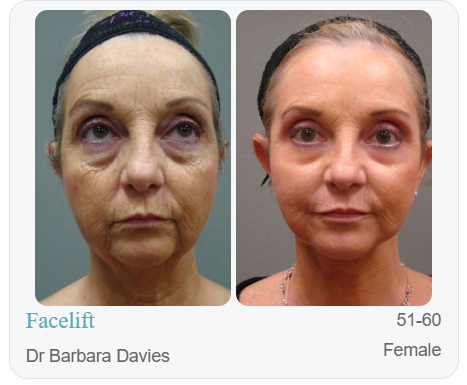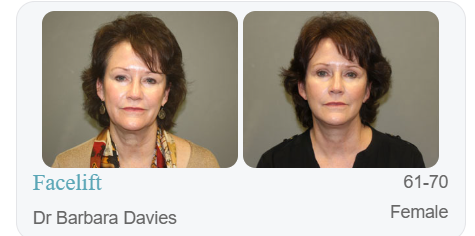Facelift in Savannah, GA
Facelifts are some of the most well-known facial surgeries, offering patients significant improvements to their signs of aging. Our plastic surgeons offer this timeless procedure to the men and women living in Savannah and the surrounding communities.

What Is a Facelift?
A facelift is a comprehensive facial surgery technique that addresses loose skin and wrinkles in the face. For many people, wrinkles and skin laxity, or sagging, are the most noticeable signs of aging. And often, the face is the first place where these effects are noticed. The facelift procedure is designed to lift and tighten the skin on the face. In some cases, the plastic surgeon may also tighten underlying muscle. This helps smooth out and minimize skin wrinkles and reduce skin sagging, rejuvenating your appearance and creating a more youthful look.
With a facelift, you can address the following areas:
- Forehead and forehead wrinkles
- Cheeks and mid-face
- Jowls
- Neck
For patients who do not need a full facelift treatment, we may recommend the FreshLook Lift®. This limited facelift procedure is focused on the lower half of the face, and specifically the jowls. The FreshLook Lift® offers the option of a less invasive procedure with less scarring and a shorter recovery time than a full facelift, although it doesn’t address the forehead.
Before & After Pictures


What Are the Benefits of a Facelift?
Everyone ages, but we don’t all age at the same rate or in the same way. When it does start to happen, the question many people ask themselves is: What do I want to do about it? For some, a facelift is the answer. Having a facelift is particularly beneficial for a number of reasons:
- It tightens facial skin and underlying muscle to smooth out and minimize lines and wrinkles and reduce or eliminate skin sag.
- It minimizes visible signs of aging and restores a more youthful appearance.
- It offers results that may last 10 years or more.
- It can improve your self-image, self-esteem, and confidence.
Who Is a Good Candidate for the Facelift Procedure?
The best candidate for facelift surgery is someone whose face has visible signs of aging and who wants a procedure that can provide a permanent solution. Ideally, they should be a non-smoker and be in good physical health. This is important to minimize surgical risk, and it makes for a smoother recovery.
Most people who have facelift are in their 40s, 50s, or 60s, but it is possible to have a facelift in your 70s or even 80s, provided your physical health is good.
Finally, it’s important to have realistic expectations about what the procedure can achieve. Altering your appearance with surgery can affect your self-image and self-esteem. Even when those changes are positive, they can sometimes be difficult to get used to. During a consultation, you can talk to your surgeon about your expectations and what’s reasonable to expect from your facelift results.
Are There Any Non-Surgical Alternatives to Having a Facelift?
Cosmetic surgery isn’t the only option if you’re interested in minimizing the signs of aging. There are many non-surgical cosmetic treatments that can achieve similar kinds of effects, like minimizing the appearance of fine lines and wrinkles and tightening sagging skin. These include:
- Sciton® Halo™ Laser Skin Resurfacing: A technique that uses laser energy to peel away the top skin layer, revealing fresher, smoother skin beneath.
- Sciton SkinTyte™ Laser Tightening: Delivers targeted laser energy to trigger the production of collagen deep within the skin.
As well as these procedures, there are injectables such as BOTOX and dermal fillers, which are available in a range of different formulations. These substances are used to smooth out fine lines and wrinkles, fill in glabella lines and nasolabial folds, and plump the lips.
While the treatments above can have similar effects as a facelift, they can’t achieve everything a facelift can. With most non-surgical procedures, you need treatments regularly to maintain the effects. Only a surgical facelift gives you results that are truly permanent.
What Happens at a Facelift Consultation?
Your facelift consultation is important for a number of reasons. Firstly, it’s a chance for you and your surgeon to talk about your goals for surgery—what you want to change and what results you’re hoping for. It’s also important because your surgeon will need to examine you to develop a plan for the surgery.
Another significant part of a consultation is setting expectations. You may have certain desires and treatment goals, and you’ll get to speak with your surgeon about whether those are achievable. Your surgeon will be able to help you by talking through and showing you what results you can expect from surgery.
As well as treatment goals and expectations, you’ll also discuss your own medical health and history. This is a vital part of the consultation, as your surgeon needs to know if you have any health conditions or are on any medications that might affect your surgery or recovery.
Finally, make sure to ask any questions you have about the surgery, whether it’s about the treatment, recovery, cost, or anything else. Only when you have all the facts can you make an informed choice about what’s best for you!
How Should I Prepare for Having a Facelift?
This is generally a matter of following any instructions your cosmetic surgeon has given you.
For instance, if you take certain medications, you may be advised to stop taking them for a period of time prior to surgery. This is generally the case for people who take blood thinners, for instance, as this class of medication increases the risk of excessive bleeding during surgery.
In addition, if you’re a smoker, your surgeon will ask you to refrain from smoking before and after surgery. This is important because smoking reduces oxygen levels in the blood and can slow down your rate of healing and recovery.
What Is the Facelift Procedure Like?
Facelifts are performed using the anesthesia appropriate for the patient. This ensures the procedure is both safe and comfortable.
The incisions for a facelift begin hidden in the hairline at the temples, proceed in a crease in front of the ears, loop around the earlobes, and disappear in the hair behind the ear. Through these incisions, we remove excess sagging skin and tighten what remains to improve facial contours and achieve the desired result.
After about three hours of surgery, the incisions are closed, and treatment is complete. The final step is the placement of a post-operative garment. This is applied to the face to provide support and protection while facial tissue and skin heals.
Facelift Aftercare and Recovery
When you wake up after the procedure, you’ll feel groggy due to the general anesthesia. Your face will feel tender and perhaps a little painful, and you’ll have some bruising and swelling.
We recommend that patients take at least a week off work and other normal activities following a facelift. This is vital to recovery, as too much activity may increase swelling and skin sensitivity and have a negative impact on the healing process. It’s also important to avoid exercise and other strenuous activities until you’re finished healing. If your surgeon has any specific instructions about your activity level during recovery, make sure to follow them closely.
Your facelift recovery experience will depend partly on the kind of procedure you’ve had. Since the FreshLook Lift is a kind of mini facelift, your recovery may be a little simpler and quicker than if you’ve had a full facelift. However, in all cases, there are some factors that can affect your facelift recovery. It’s important to be in good general health, refrain from smoking, and follow your surgeon’s aftercare instructions correctly.
Facelift Risks and Complications
Facelift Risks
A few facelift risks, like anesthesia complications or excessive bleeding, are associated with any surgical procedure. Post-facelift, the risk of developing a blood clot, or deep vein thrombosis, is 0.1%.
Following surgery, of course, there’s the risk that you may not get the results you were hoping for. There are two things you can do to prevent this from happening:
- Choose a good plastic surgeon, who has lots of experience with performing the kind of facelift you want
- Make sure your expectations for the surgery are realistic and in line with what your surgeon has discussed.
Facelift Complications
The most common complications experienced after facelift surgery are hematoma (1.1% risk) and infection (0.3% risk). A hematoma is a build-up of blood under the skin. When it occurs after a facelift, it’s usually because the patient has tried to return to normal activity levels sooner than advised. Infection can occur if surgical incisions aren’t kept clean and dry. To help keep infection at bay, make sure to take as directed any antibiotics your surgeon prescribes for you.
Another possible complication is facial nerve injury. This is extremely rare, and when it does occur, it’s typically temporary. Most people who have this issue recover fully within three to six months after surgery.
What Facelift Results Can I Expect?
The results from the facelift procedure will be noticeable immediately, but it may take a few weeks for all swelling to subside and for the full results to become visible.
The results of a facelift are permanent; however, having a facelift doesn’t slow down or stop the aging process. Your skin will still be subject to the effects of aging, so new lines and wrinkles can still form. Many patients choose to combine a facelift with skincare treatments from our Savvy Skin Medical Aesthetics & Laser Center to further enhance and maintain their results.
If you are considering a facelift or any other procedure, contact us today to schedule your initial consultation.
